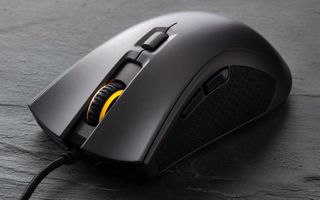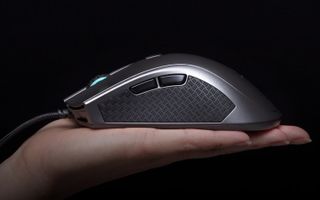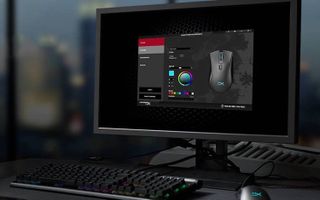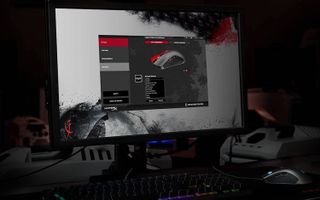HyperX Pulsefire FPS Pro Review: The Best $60 Gaming Mouse
The HyperX Pulsefire FPS Pro is a gorgeous, balanced mouse that's well worth its reasonable price of admission.
Why you can trust Tom's Guide

HyperX, which made its bones with premium, no-frills gaming headsets, has been making surprisingly good gaming mice right out of the gate. The $50 HyperX Pulsefire was solid, but a little on the plain side; the $70 HyperX Pulsefire Surge was also solid, but a little on the ostentatious side. Enter the $60 HyperX Pulsefire FPS Pro, which represents a beautiful middle ground.
It's comfortable, intuitive and has just the right amount of RGB lighting. The software is much more of a pain than it should be, but once you learn the program's ins and outs, even that's not much of a problem. The Pulsefire FPS Pro is a gorgeous, balanced peripheral that's earned a spot on our best gaming mouse page.
Design
If you've seen a right-handed ergonomic gaming mouse in the past few years, the Pulsefire FPS Pro should look very familiar. It's a medium-size (5.0 x 2.8 inches) mouse with an elevated center, which facilitates either palm or claw grips. On either side of the mouse, there are extremely coarse, textured finger rests.
The textured grips are what first endeared me to the Pulsefire FPS Pro. While textured grips are pretty common in high-end gaming mice, they're usually just pieces of rubber with a few lines or nubs. The grips on the Pulsefire FPS Pro actually feel substantial.

Their crosshatch pattern is close to being prickly, but in a way that makes it pleasant to hold rather than painful. If — and bear with me for a second, because this is going to be a very specific subset of readers — you have ever petted a hedgehog, you'll have a pretty good idea of what I mean.
The Pulsefire FPS Pro is a refinement of a design that's already been successful for HyperX.
Otherwise, the button layout on the Pulsefire FPS Pro is both conservative and sensible. There's a right button, a left button, a clickable scroll wheel and a dots-per-inch (DPI) sensitivity adjuster on the face. On the left side of the mouse, there are two small, thin, easily distinguishable thumb buttons. The whole mouse has a subtle, gray-silver sheen to it, which looks more stylish than the plain black that a lot of its competitors use.
Features
The Pulsefire FPS Pro runs on a piece of software known as HyperX Ngenuity, which controls a number of HyperX mice and keyboards. The software isn't bad, by any stretch. You can customize RGB lighting, set up profiles for individual games, adjust DPI levels, program buttons and perform all the rest of the customizations you'd expect from a modern gaming mouse.

But the software is a bit on the janky side. I had an older version of the program installed. When I opened it (after two false starts, where it pretended to open, but didn't), I clicked the update button. The first update attempt caused the program to crash. The second one worked — then it informed me that the program couldn't update any further without downloading a whole new version from the website.
Off to the HyperX website I went, to download and install the latest software version — which didn't recognize the mouse. One computer restart and firmware update later, everything seemed to be in good working order, but it was a lot of hassle to get there.

The program also doesn't have the most intuitive interface in the world. "Customize" and "edit" both manipulate completely different mouse commands, and profiles don't return to the desktop default unless you hit a very small "apply" button on the main screen. Once you learn your way around, the software is clean and functional, but it hides an awful lot of its features behind a confusing design.
MORE: How to Buy a Gaming Mouse
All of the software features are in good working order, though. The RGB lighting is bright and colorful, and you get a fair number of options for patterns. There are three onboard profiles, and as many on-computer profiles as you care to program. Beyond that, the mouse doesn't have any unusual features; it's really just about you and your games.
Performance
I ran the Pulsefire FPS Pro through a variety of genres. Even though it's called an "FPS (first-person shooter)" mouse, it feels very much like an all-purpose mouse to me. The design is perfectly suitable to just about any kind of game on the market.

The Pulsefire FPS Pro was quick, responsive and customizable whether I was building up Zerg bases in StarCraft: Remastered, facing down villainous wizards in Baldur's Gate: Enhanced Edition or challenging hordes of forest sprites in World of Warcraft.
The Pulsefire FPS Pro was quick, responsive and customizable whether I was building up Zerg bases in StarCraft: Remastered, facing down villainous wizards in Baldur's Gate: Enhanced Edition or challenging hordes of forest sprites in World of Warcraft.
I did pay special attention to how the mouse controlled during Overwatch, since it's supposed to be ideal for FPS play. Here, the textured grips proved their worth, since I had an extremely strong grasp on the mouse the entire time. Otherwise, I wouldn't say the Pulsefire FPS Pro is better than any other high-end mouse at controlling FPS titles — but it is just as good, which is a plus. As Doomfist, my shots rang true, and I was able to fire off my special abilities accurately. (Or as accurately as possible in the heat of battle, anyway.)
Bottom Line
With an accurate, high-quality sensor, smart RGB lighting and some truly inspired textured grips, the Pulsefire FPS Pro is a refinement of a design that's already been successful for HyperX.
You can usually find the Logitech G502 Proteus Spectrum in the same general price range as the Pulsefire FPS Pro — but other comparable mice usually retail for $70 or $80. For $60, it's hard to find a better gaming mouse than the Pulsefire FPS Pro.
Credit: HyperX
Sign up to get the BEST of Tom’s Guide direct to your inbox.
Upgrade your life with a daily dose of the biggest tech news, lifestyle hacks and our curated analysis. Be the first to know about cutting-edge gadgets and the hottest deals.
Marshall Honorof is a senior editor for Tom's Guide, overseeing the site's coverage of gaming hardware and software. He comes from a science writing background, having studied paleomammalogy, biological anthropology, and the history of science and technology. After hours, you can find him practicing taekwondo or doing deep dives on classic sci-fi.

